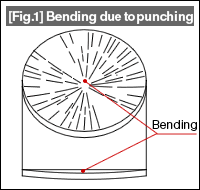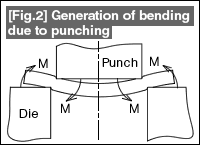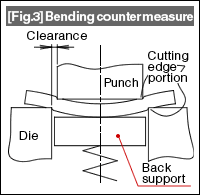HOME > Press Dies Tutorial > #163 Problems in Punching and their Countermeasures (2) Bending due to Punching
Press Dies Tutorial
#163 Problems in Punching and their Countermeasures (2) Bending due to Punching
Category : Die Design
June28, 2013
| Bending (also called warping, but here, the term bending is used to imply deformation only in one axis which is different from bending along the entire circumference) occurs in blanking operations (blank punching, outer shape punching) as shown in Fig. 1. |  |
| In the initial stage of a punching operation, the material gets deformed into a shape as shown in Fig. 2. A force (bending moment) acts on the punch and the die so as to bend the material at the clearance. Because of this, the material gets twisted and gets bent. If this bending stress does not exceed the elastic region of the material being formed, when the blank is separated from the die it returns to its original shape. If the bending stress exceeds the elastic region of the material and gets into the plastic region, the bending remains even when the blank is separated from the die. The bending becomes large as the clearance becomes large. This is because the distance between the two points increases where the force operates to twist the material. In a similar manner, this also occurs even when the cutting edges of the punch and the die wear out and become rounded. |  |
| The clearance is made small as a countermeasure in order to make the bending small. Carry out regrinding of the punch and die earlier thereby reducing the forming using worn cutting edges. This can be said to be the countermeasure in the common dies. (See Fig. 3) As a more positive countermeasure, since it is good if the bending is suppressed, there is the method of incorporating in the die a back support such as that shown in Fig. 3. |  |
The metal forming method of punching can be said to have a die structure with which it is easy for bending to occur. In the technique shown in Fig. 4 in which the part that becomes the scrap is removed and the product is left on the die, since it is possible to carry out the forming while constantly pressing the material, it is possible to make bending small (in this case, even warping can be made small). This method is being used widely in the case of products in which a high degree of flatness is required.

- #167 Problems in Punching and their Countermeasures (6) Scrap Processing in Punching
- #166 Problems in Punching and their Countermeasures (5) Trimming of Drawn and Shaped Parts
- #165 Problems in Punching and their Countermeasures (4) Scrap Clogging in Punching
- #164 Problems in Punching and their Countermeasures (3) Bending and Twisting of Narrow Punched Parts
- #163 Problems in Punching and their Countermeasures (2) Bending due to Punching



